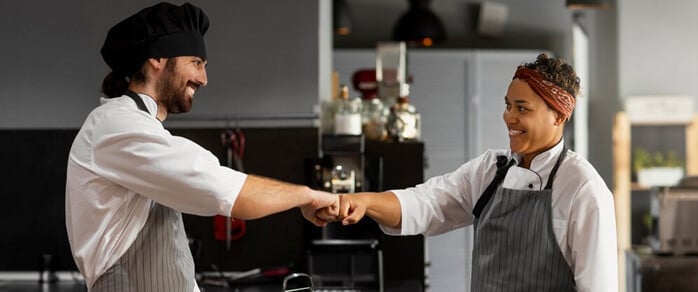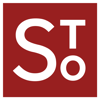
In restaurant operations, chefs and managers must work well together for everything to run smoothly. The kitchen and management teams need to work in perfect harmony to keep operations running, costs in check, and a high level of service.
But a rift can often develop between chefs who have their eyes on the plates, and managers who have theirs on budgets, stock levels and supplier relationships. Such challenges can result in inventory inaccuracies, cost overruns and operational inefficiency.
Restaurant procurement software offers one of the most powerful solutions to this communication gap. This software enhances transparency, facilitates communication, and streamlines processes between chefs and managers. With procurement software, both teams have an integrated platform that allows them to work in concert with many sections of restaurant operations.
Understanding the Procurement Process in Restaurants
Each stage of a restaurant procurement process requires a seamless interaction between the chefs and management. This cycle includes:
- Menu Planning: Chefs plan a menu around seasonality, the latest food trends, and customer needs. It is a manager's responsibility to procure the ingredients within the prescribed budget.
- Ingredient selection: In some cases, chefs will specify which ingredients to use, and managers will arrange for suppliers to source and bargain with suppliers.
- Supplier negotiation & ordering: As soon as delivery issues have arisen, managers will require suppliers to get the best deals possible within the shortest time of delivery.
- Inventory tracking & stocktaking: Each of the teams has to track the stock, maintain stock history, and foresee future orders.
In this cycle, chefs and managers take a pebble role. The chefs are the ones to push menus and ingredients needed, and managers do the inventory control, budget management and vendor management. But these can always lead to discrepancies without the correct tools, which cause uncertainty and inefficiencies then.
Key Challenges in Chef-Manager Collaboration
Despite the best intentions, hurdles often arise between chef and manager collaboration. Such issues can create barriers in the smooth functioning of operations and affect the overall efficiency:
- The wrong pass-through of inventory: Chefs do not have a real-time view of stock levels, and managers are not fully appreciative of the needs of the kitchen.
- Differences between needs vs orders: Chefs often desire premium ingredients, while managers focus on cost control and staying within budget.
- Budget conflicts: Chefs will be aiming for luxurious freshest items, while managers will be trying to keep an eye on cost government and adhere to be linked to the budget.
- Lack of real-time data: If the inventory-related data is not up-to-date, you may get last-minute orders even when you stock out, which can disrupt the kitchen flow.
- Communication inconsistency from vendor: Vendors might delay goods, miss quality metrics or not stick to an agreed price, which can be aggravating and cause delays.

Such challenges show the requirement for a solution that enhances transparency and, real-time communication of the buyers and sellers about inventory. Now, this is where procurement software for restaurants becomes a game-changer.
Role of Procurement Software in Bridging the Gap
a. Centralised Communication
The centralisation of communication is among the biggest benefits of restaurant procurement software. It saves chefs and managers the hassle of making phone calls, sending emails, or checking manual records, and instead facilitates communication and collaboration among them on a single platform. This central hub enables both teams to:
- Chefs and managers can check existing stock level status, avoiding any inventory mismatches.
- Managers can check pending orders and deliveries and chefs can know when deliveries are arriving.
- Automated alerts keep both teams informed whenever a stock reaches a certain level, thereby preventing stockouts on any products.
- Suppliers can be selected together by managers and chefs, taking into account price, quality, delivery times, etc.
This restaurant team collaboration software significantly reduces communication barriers and ensures both parties are always on the same page.
b. Real-Time Inventory & Order Visibility
Chef and manager visibility of stock levels, in real-time, is afforded to both parties by restaurant inventory and procurement software. It allows chefs to precisely visualize what ingredients are available, allowing them to plan their menus accordingly. This will save them in terms of waste and avoid any last-minute ordering. Spectre, on the other hand, allows managers to check order status, delivery timelines, and budgets for compliance. By letting both teams see what the other is doing in real time, friction is minimized and alignment is sustained.
c. Menu-Driven Procurement
Around 31% of restaurant owners refresh their menu every month. Procurement solutions offer integration into menu planning and inventory software, which will enable chefs to plan their menus based on what is currently available in inventory. When chefs plan dishes, the system can automatically suggest the necessary ingredients, taking into account current stock levels. It allows chefs to use what they already have before ordering new items, cutting down on waste. Simultaneously, managers can check the proposed menu and ensure it fits within the budget and will automatically recommend cheaper ingredient replacements as needed.
d. Approval Workflows & Budget Control
Best procurement software for restaurant teams provides customizable approval workflows. These workflows ensure that chefs request ingredients and supplies based on menu requirements, while managers approve orders based on budget constraints and vendor relationships. Automation can make this process more efficient by auto-generating purchase orders, and minimizing manual back and forth, as well as errors. Managers have better visibility into what they will be paying for procurement and chefs can ask for the best ingredients to prepare their dishes resulting in a perfect win-win for both the disciplines.
Enhanced Vendor Management & Price Tracking
As suppliers are a critical part of restaurant operations, this is important to note. Procurement software helps improve vendor and supplier management for restaurants by providing both chefs and managers with the tools to manage supplier performance and track prices. Key benefits include:
- Vendor Performance Tracking: Chefs and managers alike can score vendors based on order turnaround, quality, and customer service.
- Price comparisons: With procurement software, both teams can compare prices across multiple suppliers, ensuring that they pull in the best deals every time.
- Maintaining preferred vendor lists: Finding good quality ingredients is easier when management and cooks create a list of trustworthy suppliers.
This increased transparency helps chefs and managers make educated decisions between cost vs. quality — thus streamlining the procurement process.
Data-Driven Decision Making
By giving chefs and managers access to data-driven insights, restaurant procurement software helps them make better decisions. Dashboards of analytics showcase metrics that are surfacing, such as:
- Food cost percentages
- Ingredient usage patterns
- Order history
By using this data, chefs and managers can collaborate on:
- Cost reduction initiatives: Any places where they can save some money, whether that be moving to cheaper suppliers or changing portion sizes.
- Seasonal menu planning: Chefs can plan menus based on available inventory and managers can plan purchases based on expected demand.
- For supplier negotiations: By turn looking at the purchase history and order volume, the data-backed insights enable both teams to better negotiate deals with the suppliers.
Such data-driven decision-making propels both teams to move in unison to achieve the same financial and operational objectives.
Case Study/Real-Life Example
Consider a mid-sized restaurant that implemented kitchen inventory management software and saw significant improvements in collaboration between chefs and managers. The kitchen staff frequently ran out of critical supplies before the program, and supervisors struggled not to have too many items not being used. The restaurant observed when it applied procurement tools:
- Reduced ingredient wastage: Chefs efficiently used the ingredients with visibility of the real-time inventory, which eliminated wastage of expensive ingredients and saved costs.
- Faster menu planning: Chefs can plan menus properly on the stock available, and managers can then approve orders in a matter of clicks, minimizing the risk of missing out on an ingredient.
- Smoother vendor relationships: Centralized vendor management ensured that the restaurant factory received on-time and uninterrupted supply deliveries.
Conclusion
One of the best ways to empower chefs and managers is to use procurement software, as it improves collaboration, increases transparency, and simplifies processes. By enabling teams to view real-time supplies, make purchases based on menus, and base choices on data, this program lets both teams remain on the same page and operate effectively together. This helps companies manage their kitchens more effectively, negotiate better with their suppliers, and better control their expenses.
Whether you're a manager trying to keep costs down or a chef wanting to better handle your inventory, the right procurement software can make all the difference in making it easier for everyone to work together and improving the overall performance of your restaurant.


